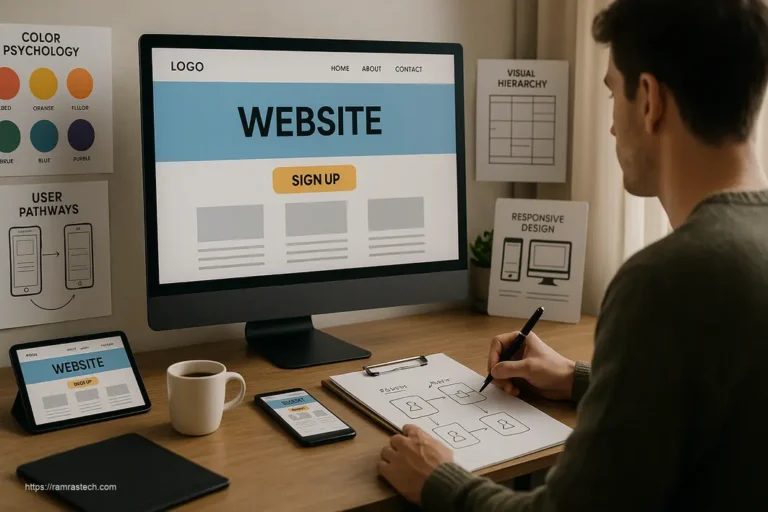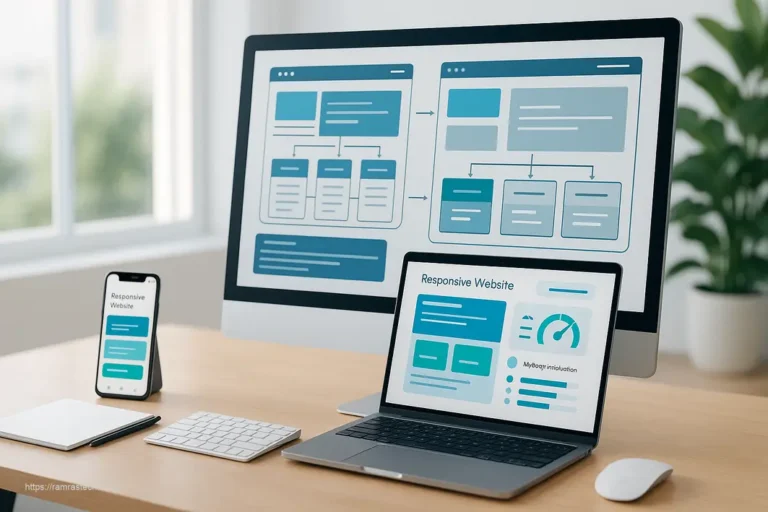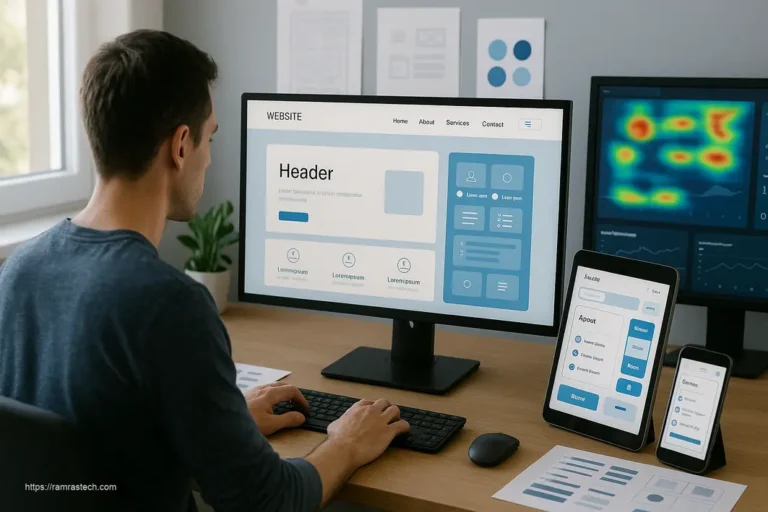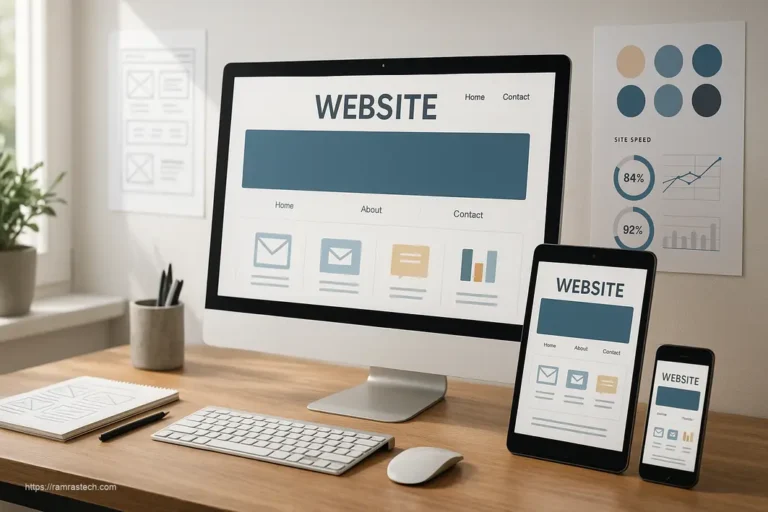10 Must-Have Website Design Features for Enhanced User Experience
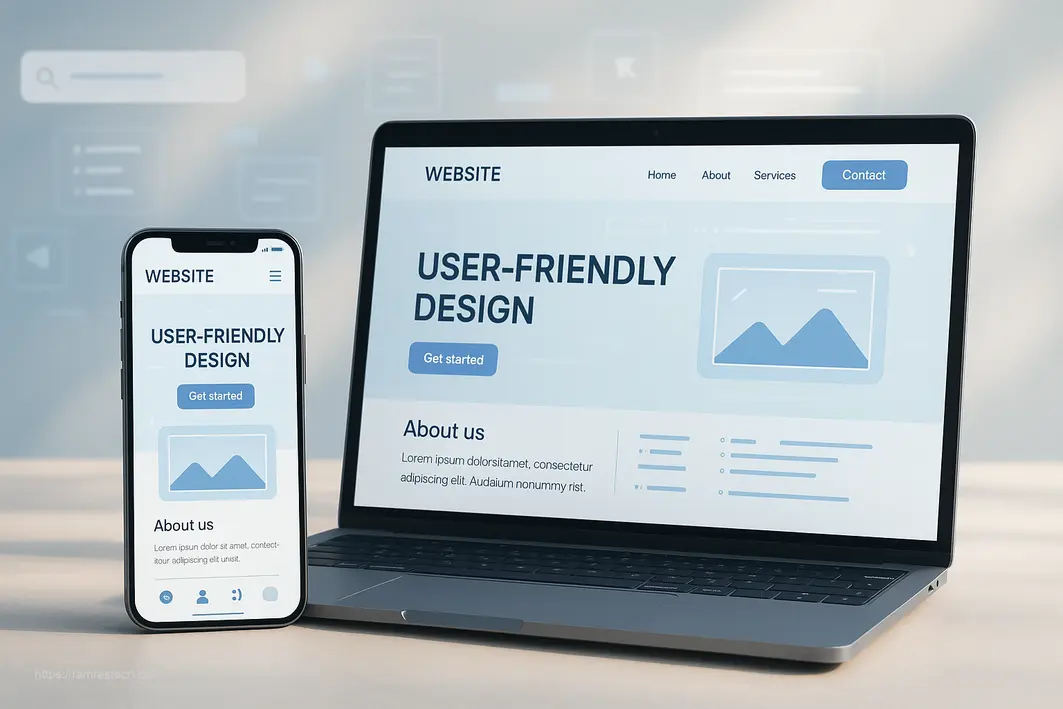
A well-designed website is essential for enhancing user experience, directly influencing how users engage with content, navigate your site, and perceive your brand. Incorporating the right website design features not only improves functionality and aesthetics but also helps keep visitors on your site longer, increases the likelihood they’ll return, and boosts overall engagement and conversion rates.
Have you ever wondered why some websites feel intuitive and enjoyable while others leave you frustrated and eager to close the tab? The difference often comes down to thoughtful design choices that prioritize the user’s needs and preferences.
Why Website Design Features Matter for Business Success
Let’s face it—your website is often the first impression potential customers have of your business. In today’s digital-first world, this virtual storefront can make or break your success. Research shows that 75% of users admit to making judgments about a company’s credibility based solely on their website design.
The stakes are high:
- 38% of people will stop engaging with a website if the content or layout is unattractive
- 88% of online consumers are less likely to return to a site after a bad experience
- First impressions are 94% design-related
These statistics highlight why investing in the right website design features isn’t just about aesthetics—it’s a business imperative that directly impacts your bottom line.
Understanding User-Friendly Design
User-friendly design refers to creating websites that are intuitive, accessible, and enjoyable to navigate for all visitors, regardless of their background or abilities. The benefits include:
- Improved accessibility: Websites that consider accessibility (e.g., alt text, contrast, keyboard navigation) are usable by a wider audience, including people with disabilities.
- Increased engagement: Well-designed sites with clear structure and navigation encourage users to explore more content and stay longer.
- Higher conversion rates: Seamless user experiences directly contribute to more completed purchases or desired actions, with good UX design driving conversion rates up by as much as 400%.
User-friendly design removes friction from the customer journey, reducing bounce rates and increasing trust in the brand. When users can effortlessly achieve their goals on your site—whether that’s finding information, making a purchase, or contacting your business—they’re more likely to become loyal customers and advocates.
15 Essential Website Design Features for 2025
1. Intuitive Navigation
Easy and clear navigation is rated as the most important feature by 94% of digital platform users. Thoughtful menu structure, visible search bars, and breadcrumb trails help users find what they need quickly, minimizing frustration.
Effective navigation should:
- Use clear, descriptive labels for all menu items
- Implement a logical hierarchical structure
- Include a sticky navigation bar that remains visible as users scroll
- Provide breadcrumbs on complex websites with multiple levels
- Limit main navigation options to 7±2 items (based on cognitive load research)
Take inspiration from Apple’s website, which maintains a clean, minimal top navigation with clearly labeled dropdown menus that organize their extensive product catalog without overwhelming visitors.
2. Responsive Design
Responsive websites ensure a smooth experience across devices and screen sizes; 99% of users expect mobile-friendly performance, and 40% will abandon sites that aren’t responsive. This is crucial for both engagement and search engine optimization.
Today’s users switch between devices constantly—from smartphones to tablets to desktops—and expect a seamless experience regardless of screen size. Since Google implemented mobile-first indexing, responsive design has become non-negotiable for SEO success as well.
A truly responsive design should:
- Automatically adjust layouts based on screen size
- Scale images appropriately without losing quality
- Have touch-friendly elements on mobile (larger buttons, adequate spacing)
- Maintain consistent branding across all device sizes
- Feature readable typography without requiring zoom
3. Fast Load Times
Speed is critical: slow-loading sites lose billions in potential revenue annually, directly impacting user satisfaction and retention. Even a 1-second delay in page response can result in a 7% reduction in conversions.
Strategies for improving load times include:
- Optimizing image sizes and formats (WebP instead of PNG/JPEG)
- Implementing lazy loading for below-the-fold content
- Minifying CSS, JavaScript, and HTML
- Utilizing browser caching
- Using Content Delivery Networks (CDNs) for global audiences
- Reducing server response time with quality hosting
According to Google, the probability of bounce increases by 32% when page load time increases from 1 second to 3 seconds. This makes speed optimization one of the most impactful website design features for both user experience and conversion rates.
4. Clear Call-to-Actions (CTAs)
Well-designed CTAs guide users to take desired actions, such as making a purchase or signing up. Effective CTAs are visible, concise, and compelling, using strong verbs and design contrast.
The best CTAs share these characteristics:
- Use action-oriented language (“Get Started” rather than “Submit”)
- Create a sense of urgency or excitement
- Stand out visually through color contrast and strategic positioning
- Communicate value proposition clearly
- Are strategically placed along the user journey
A/B testing different CTA variations can dramatically improve conversion rates. For instance, one company increased conversions by 90% simply by changing their button text from “Buy now” to “Get your free trial.”
5. Consistency and Branding
Maintaining consistent branding through colors, fonts, and imagery creates a cohesive, trustworthy user experience. 75% of users judge a site’s credibility based on design consistency.
Brand consistency builds trust by creating a recognizable identity across all touchpoints. This includes:
- Using a cohesive color palette that reflects your brand personality
- Limiting font choices to 2-3 complementary typefaces
- Maintaining consistent spacing and layout principles
- Applying the same visual style to all images and graphics
- Ensuring voice and messaging align with your brand guidelines
This consistency helps visitors understand they’re still on your website as they navigate between pages, reducing cognitive load and building trust through familiarity.
6. High-Quality Content Layout
Organized content improves readability; features like headings, bullet points, and ample white space boost engagement and legibility. 70% of users prefer content with bullet points, and well-structured layouts enhance perceived credibility.
Effective content layout strategies include:
- Using a clear hierarchy with H1, H2, and H3 headings to organize information
- Keeping paragraphs short (3-4 sentences maximum)
- Incorporating bulleted or numbered lists for scannable information
- Adding sufficient white space to prevent visual overload
- Using columns or grids to organize related information
- Including relevant, high-quality images to break up text
The F-pattern (for text-heavy content) and Z-pattern (for visual content) are two proven layout approaches that align with natural eye movement patterns, making your content more accessible and engaging.
7. Accessibility Features
Incorporating accessibility features (e.g., alt text, sufficient color contrast, keyboard navigation) ensures usability for people with disabilities and can increase engagement by 35%.
Accessibility isn’t just about compliance with standards like WCAG (Web Content Accessibility Guidelines)—it’s about creating an inclusive experience for all users. Key accessibility features include:
- Proper heading structure for screen readers
- Alt text for all images
- Sufficient color contrast (minimum 4.5:1 ratio for normal text)
- Keyboard navigability for those who can’t use a mouse
- Captions for video content
- Descriptive link text instead of generic “click here” phrases
Implementing these features opens your website to the approximately 15% of the global population with disabilities while generally improving usability for everyone.
8. Secure Design Elements
Visible security features—such as SSL certificates and secure payment gateways—build user trust and protect sensitive information, which is vital for site credibility.
In an era of increasing privacy concerns and data breaches, demonstrating your commitment to security is crucial. Important security elements include:
- SSL certification with visible indicators (padlock icon, HTTPS)
- Transparent privacy policies written in plain language
- Visible trust badges from recognized security providers
- Secure payment gateways with familiar logos
- GDPR and other regulatory compliance notices
- Two-factor authentication options for user accounts
When users feel their data is safe, they’re more willing to engage with your site, create accounts, and complete transactions—directly impacting your conversion rates and customer loyalty.
9. Engaging Visual Design
Quality visuals, including images, graphics, and videos, can increase the time users spend on a site by up to 88%. The key is to use visuals strategically without creating clutter.
Effective visual design balances aesthetic appeal with purpose and includes:
- High-quality, relevant images that enhance rather than distract
- Visual hierarchy that guides users’ attention to important elements
- Strategic use of color to evoke emotions and highlight key areas
- Custom icons and illustrations that reinforce your brand identity
- Videos that explain complex concepts or demonstrate products
- Subtle animations that provide feedback or guide navigation
Visual elements should always serve a purpose—whether that’s explaining a concept, evoking an emotion, or directing attention to key content or calls to action. Implementing these design ideas can significantly boost your social media presence as well, creating a cohesive brand experience across platforms.
10. Search Functionality
Efficient search functions help users locate specific information quickly, reducing frustration and supporting deeper site exploration, especially on content-heavy or e-commerce platforms.
A well-designed search feature should include:
- Prominent placement in the navigation
- Autocomplete/predictive search suggestions
- Spelling correction and synonym recognition
- Filters to refine search results
- Visually appealing results pages
- “No results” pages with helpful alternatives
For e-commerce sites, robust search functionality can increase conversion rates by up to 50%, as it helps users find exactly what they’re looking for without having to navigate through multiple categories.
11. Microinteractions
Microinteractions are small animations or feedback elements that respond to user actions, creating a more engaging and intuitive experience. These subtle design elements communicate status, provide feedback, and guide users through processes.
Effective microinteractions include:
- Button hover effects that indicate clickability
- Form field validation feedback
- Loading animations that reduce perceived wait time
- Success messages after completing actions
- Subtle page transitions that maintain context
- Like/heart animations on social features
These small details might seem insignificant individually, but collectively they create a polished, responsive feel that users appreciate—often subconsciously—and that distinguishes professional websites from amateur ones.
12. Social Proof Elements
Social proof components like testimonials, reviews, and user counts help build credibility and trust. According to research, 92% of consumers read online reviews before making purchase decisions.
Effective social proof elements include:
- Customer testimonials with photos and specific details
- Product reviews with rating systems
- Case studies highlighting successful customer outcomes
- Client logos for B2B businesses
- User statistics (e.g., “Joined by over 10,000 businesses”)
- Social media integration showing real-time engagement
Leveraging social media marketing effectively can generate valuable social proof that can then be featured on your website, creating a virtuous cycle of credibility-building.
13. Personalization Capabilities
Personalized experiences that adapt to user preferences and behaviors can increase conversion rates by 20% and engagement by 56%. Modern websites increasingly use data to tailor content to individual visitors.
Effective personalization features include:
- Recommended products based on browsing history
- Location-based content adaptation
- Personalized greeting for returning users
- Content recommendations based on previous engagement
- User preference settings that persist across sessions
- Behavior-triggered offers and messages
Personalization must balance effectiveness with privacy concerns, always giving users transparency and control over their data. When implemented thoughtfully, personalization creates a more relevant experience that feels helpful rather than intrusive.
14. Dark Mode Option
Dark mode has become an increasingly popular website design feature, with 81.9% of users choosing dark mode where available. This feature reduces eye strain, conserves battery life on mobile devices, and provides an alternative aesthetic that many users prefer.
Effective dark mode implementation includes:
- Maintaining readability with proper contrast ratios
- Respecting user system preferences automatically
- Providing an easy toggle between light and dark modes
- Ensuring all UI elements are visible in both modes
- Using slightly desaturated colors in dark mode to reduce visual vibration
Offering this choice demonstrates attention to user preferences and accessibility needs, contributing to a more positive overall experience.
15. Performance Analytics Integration
While invisible to users, built-in analytics are a crucial website design feature that enables continuous improvement. Analytics help you understand how users interact with your site and identify opportunities for enhancement.
Key analytics integrations should track:
- User flow and navigation patterns
- Conversion funnel performance
- Page load and interaction times
- Device and browser usage
- Search queries and results effectiveness
- Scroll depth and engagement metrics
Understanding Google Analytics is essential for making data-driven design decisions that continuously improve your user experience based on actual behavior rather than assumptions.
How to Prioritize Website Design Features for Your Business
With so many important website design features to consider, how do you decide where to focus your efforts and budget? Start by considering these factors:
- Business goals: Align design features with your primary objectives (e.g., lead generation, sales, information sharing)
- User needs: Research your audience to understand their preferences, pain points, and device usage patterns
- Current performance: Analyze your existing website to identify the most significant usability issues
- Industry standards: Research competitor websites and industry benchmarks
- Technical constraints: Consider your CMS capabilities, development resources, and maintenance capacity
You don’t need to implement all 15 features at once. Instead, create a phased approach that tackles the most impactful elements first. Often, improvements to core features like navigation, responsiveness, and speed will deliver the greatest initial ROI.
The Future of Website Design Features
As technology evolves, so do user expectations for website design features. Emerging trends to watch include:
- Voice user interfaces: Integration with voice assistants for hands-free navigation
- Augmented reality experiences: Try-before-you-buy product visualization
- AI-powered personalization: More sophisticated content and experience tailoring
- Motion design: Subtle animations that guide users and create emotional connections
- Zero-UI concepts: Interfaces that minimize visible controls in favor of intuitive interactions
While it’s important to stay aware of these trends, remember that the fundamental principles of good design remain constant: clarity, usability, accessibility, and purposeful aesthetics.
Measuring the Impact of Your Website Design Features
Implementing new website design features is just the beginning—measuring their impact is essential for ongoing optimization. Key metrics to track include:
- Bounce rate: Are users staying on your site or leaving immediately?
- Time on site: How long do users engage with your content?
- Pages per session: Are users exploring multiple pages?
- Conversion rate: Are users completing desired actions?
- User feedback: What are users saying about their experience?
- Heat maps: Where are users clicking, hovering, and scrolling?
A/B testing different design variations can provide concrete data about which website design features work best for your specific audience and goals.
FAQ: Common Questions About Website Design Features
How much do professional website design features cost to implement?
Costs vary widely depending on complexity, with basic features like responsive design costing $1,000-$3,000 and comprehensive implementations reaching $10,000-$30,000 for custom solutions. Many features can be added incrementally to spread costs over time, and some are available through plugins or templates for popular platforms like WordPress, reducing implementation costs.
Which website design features have the biggest impact on SEO?
Responsive design, fast load times, and clear navigation structure have the most significant impact on SEO because they directly affect user engagement metrics that Google considers in rankings. Implementing SEO-friendly web design services should include proper heading structure, semantic HTML, descriptive image alt text, and clean code that search engines can easily crawl and index.
How often should website design features be updated?
Major website redesigns typically occur every 2-3 years, but continuous improvement is preferable. Regular user testing (quarterly) can identify friction points, while analytics monitoring should be ongoing. Technology changes (like new browser capabilities) may require updates, and competitive analysis should be conducted annually to ensure your website remains current with industry standards.
Can I implement these website design features with a template site?
Many premium templates for WordPress, Shopify, and other platforms incorporate key features like responsive design, fast loading, and accessibility. However, template limitations include restricted customization options and potential bloat from unused features. For best results, choose a template with essential features for your business needs, then customize it for your specific audience and brand.
How do I know if my website design features are working effectively?
Combine quantitative metrics (analytics data on bounce rates, conversions, and engagement) with qualitative feedback (user testing, surveys, and direct customer feedback). Look for patterns in user behavior and feedback, then make targeted improvements. A/B testing specific changes can provide clear evidence of what works best for your unique audience.
Conclusion: Creating a Balanced Approach to Website Design Features
Implementing the right website design features requires balancing aesthetics, functionality, and business objectives. The most effective websites aren’t necessarily those with the most features, but those that thoughtfully implement the elements that matter most to their specific users and goals.
Remember that good design isn’t static—it evolves based on user feedback, technological capabilities, and changing business needs. By focusing on core principles of usability while staying adaptable to new opportunities, you can create a website that not only looks great but genuinely serves your users and advances your business objectives.
The 15 website design features outlined in this article provide a comprehensive foundation for creating exceptional user experiences. By thoughtfully implementing these elements with your specific audience in mind, you can create a website that stands out in an increasingly competitive digital landscape.
Next Steps: Evaluating and Improving Your Website
Ready to enhance your website design features? Consider these action steps:
- Conduct a comprehensive audit of your current website against the 15 features discussed
- Survey your users to understand their specific pain points and preferences
- Prioritize improvements based on potential impact and implementation difficulty
- Create a phased implementation plan with clear metrics for success
- Consider consulting with UX design professionals for specialized guidance
Remember that even small, incremental improvements can significantly enhance your users’ experience and your business results.
Have you implemented any of these website design features recently? What impact did you notice? Share your experiences in the comments below, and let’s learn from each other’s successes and challenges.

